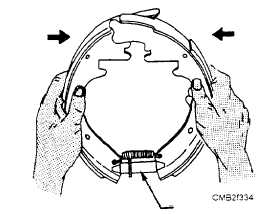shoe retainers must be removed next. Figure 7-31 shows one type being removed with a pair of ordinary combination pliers. Heavy-duty brake shoes are mounted on separate anchor pins. Some of these installations require the removal of the anchor pins, while others require the removal of clips on the end of these pins before the brake shoes can be removed.
On light-duty applications, you can now grasp the shoes (fig. 7-32) and lift them off the backing plate. After they are removed, allow the shoes to move together (fig. 7-33). This allows easy removal of the spring and adjusting screw assembly. Disassemble the adjusting screw and lubricate with a high-temperature lubricant.

Figure 7-31. - Removal of a brake shoe retainer.

Figure 7-32. - Removing shoes from the backing plate.

Figure 7-33. - Removing adjusting screw assembly.
If the lining is riveted and is to be replaced, you should mark the front and rear shoe. This action will aid in reassembly. Wipe off the backing plate thoroughly with a rag. If the backing plate is coated with brake fluid or axle lubricant, wash it with an approved cleaner. Once the backing plate is clean, apply a light coat of high-temperature lubricant to the raised pads on the backing plate. This will keep the shoes from squeaking after they are reassembled. Avoid using too much lubricant or the linings can become contaminated and ruined.
New linings are secured to the shoes by riveting or bonding. Bonded brake linings are supplied with the linings already attached to the shoes. At some activities, the old shoes must be exchanged when issued new shoes from the parts room. Linings that require rivets to attach the linings to the shoes are provided in kits. These kits provide enough linings and rivets for one or more wheels. The linings are predrilled and countersunk for the rivets and arced to match the brake shoes.
Some shops have specialized equipment to remove and replace the riveted linings. However, if the equipment is not available. the old linings can be removed with a drill and oversized bit, punch, and hammer. Take care not to enlarge the rivet holes in the shoes. If the rivet holes are enlarged, the shoe should be discarded.
Most NCF shops have a device for installing rivets. This device comes with adapters for use with various size rivets. When installing rivets. you always start in the center of the lining and work alternately to each end. Make sure the rivets are tight enough to hold the lining securely without splitting the lining at the rivet holes. For installation of the new shoes, refer to the manufacturer's service manual. Your service manual will have illustrations for the particular brake design being serviced. Use them to ensure all parts are positioned correctly, on the backing plate. When reassembling the brake assemblies, ask yourself the following questions:
Are the wheel cylinders in perfect condition and assembled properly?
Did I lubricate the backing plate and star wheel?
Is the primary (smaller) lining facing the front of the vehicle and the secondary (larger) lining facing the rear?Continue Reading
